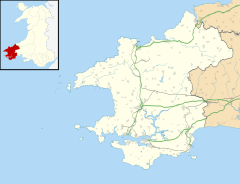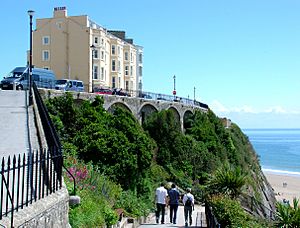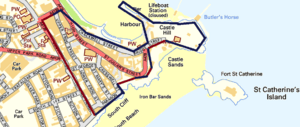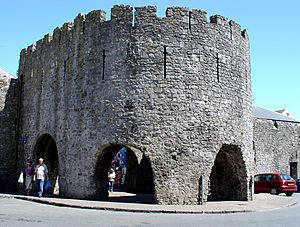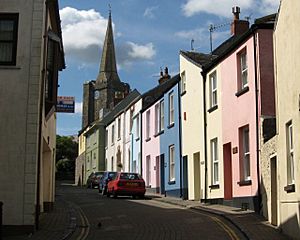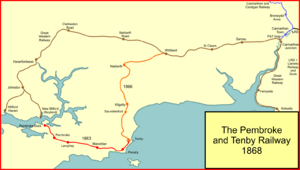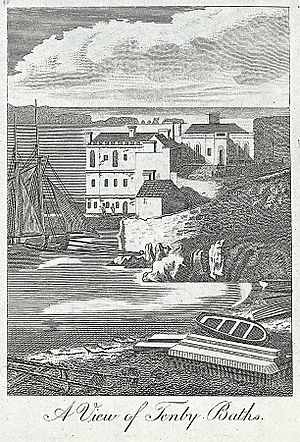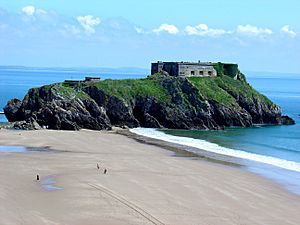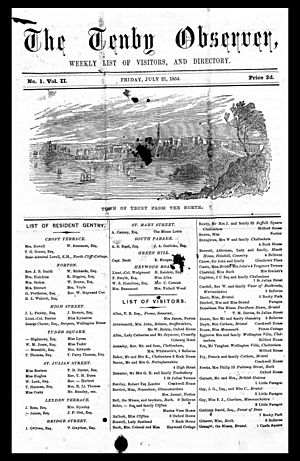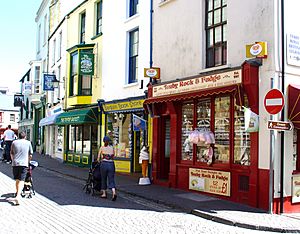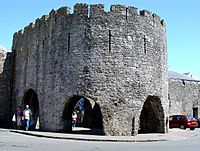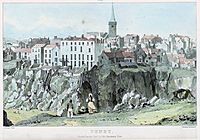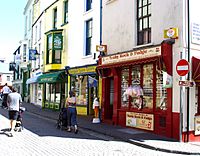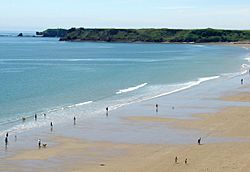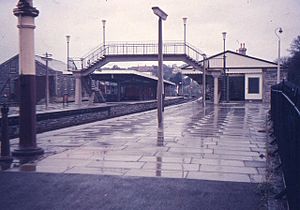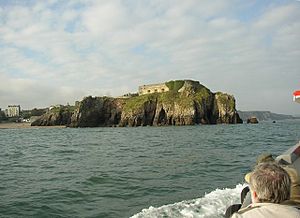Tenby facts for kids
Quick facts for kids Tenby
|
|
|---|---|
 The harbour and old town |
|
| Population | 4,696 (2011 census) |
| OS grid reference | SN129007 |
| Principal area | |
| Ceremonial county | |
| Country | Wales |
| Sovereign state | United Kingdom |
| Post town | TENBY |
| Postcode district | SA70 |
| Dialling code | 01834 |
| Police | Dyfed-Powys |
| Fire | Mid and West Wales |
| Ambulance | Welsh |
| EU Parliament | Wales |
| UK Parliament |
|
| Welsh Assembly |
|
| Website | www.aroundtenby.co.uk |
Tenby (Welsh: Dinbych-y-pysgod, lit. 'fortlet of the fish') is both a walled, seaside town in Pembrokeshire, Wales, on the western side of Carmarthen Bay, and a local government community.
Notable features include 2+1⁄2 miles (4.0 km) of sandy beaches and the Pembrokeshire Coast Path, the 13th century medieval town walls, including the Five Arches barbican gatehouse, Tenby Museum and Art Gallery, the 15th century St. Mary's Church, and the National Trust's Tudor Merchant's House.
Boats sail from Tenby's harbour to the offshore monastic Caldey Island. St Catherine's Island is tidal and has a 19th century Palmerston Fort.
The town has an operating railway station. The A478 road from Cardigan, Ceredigion, connects Tenby with the M4 via the A477, the A40 and the A48 in approximately 40 miles (64 km).

Contents
History
With its strategic position on the far west coast of the British Isles, and a natural sheltered harbour from both the Atlantic Ocean and the Irish Sea, Tenby was a natural settlement point.
The earliest reference to a settlement at Tenby is in "Etmic Dinbych", a poem probably from the 9th century, preserved in the 14th century Book of Taliesin. At this point the settlement was probably a hill fort, the mercantile nature of the settlement possibly developing under Hiberno-Norse influence.
Tenby was taken by the Normans, when they invaded West Wales in the early 12th century. The town's first stone-wall fortification was on Castle Hill. Tenby's mercantile trade grew as it developed as a major seaport in Norman controlled Little England beyond Wales. However, the need for additional defences became paramount after the settlement and castle were successfully attacked and sacked by Welsh forces of Maredudd ap Gruffydd and Rhys ap Gruffydd in 1153. Sacking of the town was repeated in 1187 and again by Llywelyn ap Gruffudd in 1260. After the final attack, William de Valence, 1st Earl of Pembroke ordered the construction of the town's large outer walls in the late 13th century. The stone curtain wall, towers and gates enclosed a large part of the settlement (in what is now known as the "old town"). With the construction of the town walls, Tenby Castle was made obsolete and had been abandoned by the end of the 14th century.
In 1457, Jasper Tudor, the uncle of Henry Tudor, agreed to share with the town's merchants the costs of refurbishing and improving Tenby's defences because of its economic importance to this part of Wales. Work included heightening the wall to include a second tier of higher arrow slits behind a new parapet walk. Additional turret towers were added to the ends of the walls where they abutted the cliff edges, and the dry ditch outside walls was widened to 30 feet (9.1 m).
Consequently, in the Late Middle Ages, Tenby was awarded royal grants to finance the maintenance and improvement of its defences and the enclosure of its harbour. Traders sailed along the coast to Bristol and Ireland and further afield to France, Spain and Portugal. Exports included wool, skins, canvas, coal, iron and oil; while in 1566 Portuguese seamen landed the first oranges in Wales. It was during this period that the town was so busy and important, it was considered to be a national port. During the Wars of the Roses Henry Tudor, the future King Henry VII of England, sheltered at Tenby before sailing into exile in 1471.
In the mid 16th century, the large D-shaped tower known as the "Five Arches" was built following fears of a second Spanish Armada.
Demise
Two key events caused the town rapid and permanent decline in importance. First, Tenby declared for Parliament in the English Civil War. After resisting two attempts by the Royalists forces of Charles Gerard, 1st Earl of Macclesfield, it was finally taken in 1648. Ten weeks later the shattered town was surrendered to Colonel Thomas Horton, who welcomed Oliver Cromwell shortly afterwards. Second, a plague outbreak killed half of the town's remaining population in 1650.
With limited infrastructure, resources and people, the town's economy fell into decline. Most of the merchant and business class left, resulting in the town's decay and ruin. By the end of the 18th century, John Wesley noted during his visit how: "Two-thirds of the old town is in ruins or has entirely vanished. Pigs roam among the abandoned houses and Tenby presents a dismal spectacle."
Revival
Ironically it was another war that led to a resurgence in Tenby's fortunes. Since 1798, the French General Napoleon Bonaparte had begun conquering Europe restricting the rich British upper classes from making their Grand Tours to continental spa towns. In 1802 local resident, merchant banker and politician, Sir William Paxton, bought his first property in the old town. From this point onwards he invested heavily in the area with the full approval of the town council.
With the growth in saltwater sea-bathing for health purposes, Paxton engaged engineer James Grier and architect Samuel Pepys Cockerell (the same team who had built his home at Middleton Hall) to create a "fashionable bathing establishment suitable for the highest society." His sea-bathing baths came into operation in July 1806 and, after acquiring the Globe Inn, transformed it into "a most lofty, elegant and convenient style" to lodge the more elegant visitors to his baths. Cottages were erected adjoining the baths with adjoining livery stables and coach house.
In 1814 a road built on arches overlooking the harbour was built at Paxton's full expense. He later had a Private Act of Parliament passed that enabled fresh water to be piped through the town. Despite these accomplishments, his 1809 theatre was closed in 1818 due to lack of patronage.
Paxton also took in "tour" developments in the area as required by rich Victorian tourists. This included the discovery of a chalybeate spring in his own park at Middleton Hall, and coaching inns from Swansea to Narberth. He also built Paxton's Tower, in memorial to Lord Nelson whom he had met in 1802 when mayor of Carmarthen. Paxton's efforts to revive the town succeeded, and even when victory at the Battle of Trafalgar reopened Europe, the growth of Victorian Tenby was inevitable.
Through both the Georgian and Victorian eras Tenby was renowned as a health resort and centre for botanical and geological study. With many features of the town being constructed to provide areas for healthy seaside walks, due to the walkways being built to accommodate Victorian nannies pushing prams, many of the beaches today still retain good disabled access. In 1856 writer Mary Ann Evans (pen-name George Eliot) accompanied George Henry Lewes to Tenby to gather materials for his work Seaside Studies published in 1858.
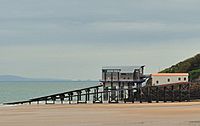
In 1852, the Shipwrecked Fishermen and Mariners' Royal Benevolent Society deployed a lifeboat to the town, taken over in 1854 by the Royal National Lifeboat Institution. This led in 1905 to the building of the first slip-way equipped lifeboat station, which was replaced in 2008.
Tenby railway station was opened by the Pembroke and Tenby Railway as the terminus of the branch from the Pembroke direction in 1863, with the section eastwards to join the main line at Whitland following three years later.
In 1867, the construction of the Palmerston Fort on St Catherine's Island began. It was built to protect the coastline from a potential landing force.
Today
There are more than 200 listed buildings and other structures in and around Tenby.
The old town castle walls still survive, as does the Victorian revival architecture in a pastel colour scheme. The economy is still based on tourism, supported by a range of craft, art and other stores.
Climate
As with the rest of Wales and the wider United Kingdom, Tenby experiences a maritime climate with cool summers and mild winters, and often high winds. Due to its coastal southwest position, it is one of the sunnier locations in Wales.
| Climate data for Tenby 5m asl, 1971-2000 | |||||||||||||
|---|---|---|---|---|---|---|---|---|---|---|---|---|---|
| Month | Jan | Feb | Mar | Apr | May | Jun | Jul | Aug | Sep | Oct | Nov | Dec | Year |
| Average high °C (°F) | 8.5 (47.3) |
8.0 (46.4) |
9.7 (49.5) |
11.7 (53.1) |
14.8 (58.6) |
17.3 (63.1) |
19.5 (67.1) |
19.3 (66.7) |
17.1 (62.8) |
14.2 (57.6) |
11.2 (52.2) |
9.5 (49.1) |
13.4 (56.1) |
| Average low °C (°F) | 3.1 (37.6) |
2.8 (37.0) |
3.8 (38.8) |
4.7 (40.5) |
7.4 (45.3) |
9.9 (49.8) |
12.0 (53.6) |
11.8 (53.2) |
10.3 (50.5) |
8.3 (46.9) |
5.3 (41.5) |
4.0 (39.2) |
7.0 (44.6) |
| Average precipitation mm (inches) | 115.4 (4.54) |
90.1 (3.55) |
87.2 (3.43) |
61.3 (2.41) |
51.5 (2.03) |
66.6 (2.62) |
52.7 (2.07) |
92.7 (3.65) |
101.6 (4.00) |
131.3 (5.17) |
129.9 (5.11) |
126.4 (4.98) |
1,106.5 (43.56) |
| Mean monthly sunshine hours | 58.0 | 75.4 | 115.6 | 184.8 | 218.2 | 205.8 | 218.9 | 200.6 | 149.1 | 106.0 | 71.7 | 49.9 | 1,654 |
| Source: Met Office | |||||||||||||
Tourism
Tenby is a busy holiday resort in the summer. Most shops, pubs and restaurants in Tenby are specifically marketed to tourists. There are coastal boat trips to offshore islands and the town is a base for exploration of Pembrokeshire.
The annual Ironman Wales competition extends the visitor season into September.
Transport
Tenby railway station serves the town on the Pembroke Dock branch of the West Wales Line operated by Transport for Wales Rail, who also manage the station. Trains run in each direction; westwards towards Pembroke and eastwards to Whitland, Carmarthen and Swansea. During peak season, trains run direct from Paddington to Tenby.
The nearest airport is Cardiff International.
Amusement Games Arcade Programmes List
- Super Street Fighter II (1996) (In Arcade Games Room Amusement In Heatherton Activity Park)
- Super Street Fighter II Turbo (1996) (In Arcade Games Room Amusement In Heatherton Activity Park)
Sport
Tenby United RFC, a rugby union club has existed since 1876. It is a member of the Welsh Rugby Union.
In 1970, the Tenby Sea Swimming Association started the Boxing Day Swim. It is Tenby's main Christmas attraction now, with approximately 600 swimmers, most in fancy dress, watched by thousands of onlookers. Each swimmer who enters for a charity receives a medal. The Osborne family has been associated with the event from the beginning and Chris Osborne, chairman of TSSA has seen it take place in every weather condition, from brilliant sunshine to freezing winds.
Tenby hosts the Welsh Ironman Triathlon in September. There is also the Tenby Aces Cycling Club and the 18-hole Tenby Golf Course that provides links golf by the coast.
Education
There are four schools in the Tenby schools area, consisting of three primary schools and one secondary school: Ysgol Hafan-y-Mor, Tenby Church in Wales Primary School, St. Teilo's RC School and Ysgol Greenhill Secondary.
Pupils from St. Teilo's School and Tenby Church in Wales School are automatically enrolled in the Greenhill School, but parents can enrol them into a different school. Ysgol Hafan y Môr is a Welsh language medium school. Most of the pupils go on to Ysgol y Preseli, a Welsh-medium secondary school in Crymych.
Previous schools in the area were Tenby V.C. Infants School which was an English medium school with a Welsh unit. Pupils from this school would automatically enrol in Tenby Junior School which has now been converted into Ysgol Hafan y Môr. Tenby V.C. Infant school was demolished in 2016 and turned into a field for the nearby Greenhill School.
Notable people
- Alison Bielski, poet and writer
- Michael Bonacini, chef, born and raised in Tenby
- Rhidian Brook, writer, born in Tenby
- Ernle Chatfield, 1st Baron Chatfield, educated at St Andrew's School, Tenby
- Charles Dale, actor, born in Tenby
- Kenneth Griffith, actor
- Augustus John, artist, born in Tenby
- Gwen John, artist
- Kate Lamb, actress, grew up in Tenby
- Michael Lieber, actor
- Clive Merrison, actor
- Charles Norris, etcher
- Gwilym Prichard, artist
- Robert Recorde, mathematician
Images for kids
See also
 In Spanish: Tenby para niños
In Spanish: Tenby para niños


